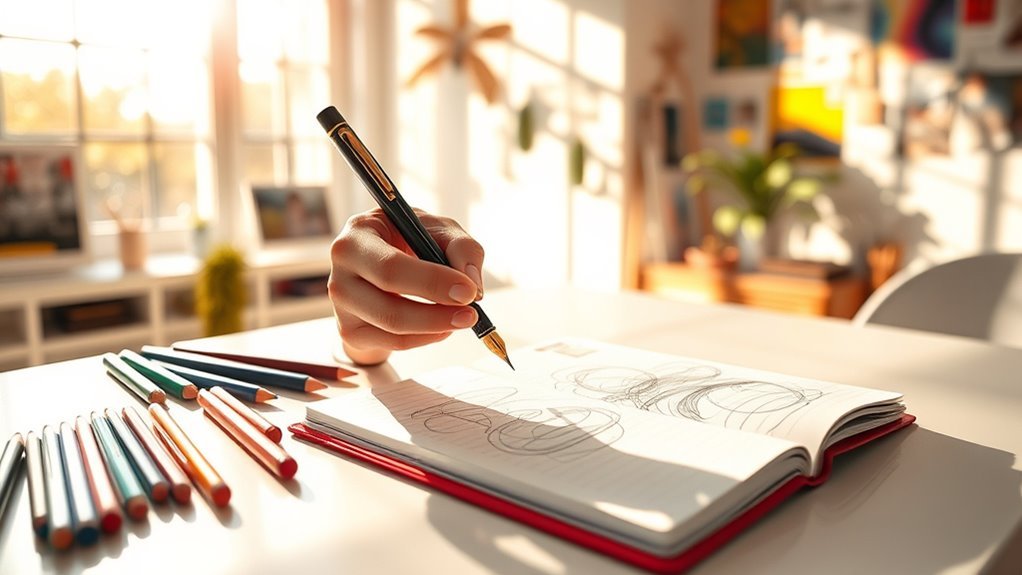Prompt writing is your gateway to unleashing creativity. By guiding your thoughts, prompts spark new ideas and help you navigate through mental blocks. They come in various forms, from visual art and writing to music composition. Crafting effective prompts involves clarity and emotional resonance, allowing for personal interpretation. Embracing collaborative efforts can further enrich your creative process. Want to enhance your skills and explore more techniques? There’s so much more to discover!
Understanding the Importance of Prompts in Creativity
While you might think creativity springs solely from inspiration, prompts play an essential role in guiding your imagination. Their significance can’t be underestimated; prompts act as catalysts that spark new ideas and perspectives. By providing a starting point, they enhance creativity and help you break through mental blocks. When you’re unsure where to begin, a well-crafted prompt can redirect your thoughts and ignite your passion. Embracing prompts allows you to explore different avenues, cultivating a more vibrant creative process. So, don’t shy away from using them—let their power fuel your artistic journey and release your true potential.
Types of Prompts for Different Creative Disciplines
When it comes to creativity, different disciplines call for unique prompts to spark inspiration. Whether you’re exploring visual art, writing, or music composition, understanding the types of prompts can enhance your creative process. Let’s look at some effective prompts tailored for each of these artistic avenues.
Visual Art Prompts
Visual art prompts serve as a powerful catalyst for creativity, igniting inspiration and guiding artists toward new ideas. These prompts can push your boundaries and encourage exploration of various elements. Consider these ideas:
- Explore abstract concepts through surreal imagery.
- Experiment with color symbolism to evoke emotions.
- Create visual storytelling pieces inspired by nature.
- Immerse yourself in texture exploration to enhance your work.
- Incorporate cultural influences to broaden your artistic styles.
Writing Prompts Variations
Expanding on the creativity sparked by visual art prompts, writing prompts offer a similar opportunity for exploration across various literary disciplines. You can experiment with prompt variations like character sketches, dialogue starters, or setting descriptions to ignite your imagination. Each type encourages unique creative exploration; for instance, a character-driven prompt can lead to rich backstories, while a setting-focused one might inspire vivid world-building. Don’t hesitate to mix and match these prompts to create layered narratives. The flexibility of writing prompts invites you to express your voice, push boundaries, and investigate deeper into your creativity. Embrace the freedom they provide!
Music Composition Ideas
While exploring music composition, you’ll find that prompts can serve as powerful catalysts for creativity. Here are some ideas to spark your imagination:
- Create melodic themes based on emotional motifs.
- Experiment with rhythmic patterns that tell a story.
- Blend different genres to explore genre fusion.
- Develop harmonic structures inspired by unique instrumentation choices.
- Use lyrical inspirations to build immersive soundscapes.
Dive into improvisational exercises that challenge your creativity and push boundaries. This approach can lead to unexpected discoveries, enriching your musical storytelling and enhancing your overall composition skills. Let these prompts guide you toward new artistic horizons!
Techniques for Crafting Effective Prompts
Crafting effective prompts is essential for guiding creativity and eliciting meaningful responses. Start by ensuring prompt clarity; make your intentions clear so the responder knows exactly what to explore. Next, focus on prompt specificity; provide enough details to inspire unique ideas without stifling creativity. For example, instead of saying “write about nature,” try “describe a hidden forest at dusk, filled with mysterious sounds.” This approach sparks imagination while maintaining direction. Finally, encourage freedom by leaving room for personal interpretation. By balancing clarity and specificity, you’ll create prompts that ignite passion and generate rich, diverse responses.
Using Visual Stimuli to Inspire Prompt Ideas
Visual stimuli can be powerful tools for igniting creativity and generating prompt ideas. By engaging with various visual cues, you can reveal sensory experiences that inspire artistic interpretations. Consider exploring:
- Color symbolism to convey emotions
- Imagery exploration for unique perspectives
- Thematic connections between visuals and narratives
- Emotional resonance found in abstract representations
- Context influence shaping your creative direction
These elements help you probe deeper into narrative visuals, sparking innovative ideas. Embrace the freedom that comes from letting visuals guide your creative process, and watch as your prompts come alive with fresh energy and inspiration.
The Role of Emotion in Prompt Writing
Emotion serves as an essential catalyst in prompt writing, shaping the depth and resonance of your creative expressions. When you tap into emotions, you reveal the potential for emotional resonance, making your work more relatable and impactful. Think about the feelings you want to evoke—joy, sadness, anger—and let those guide your prompts. This emotional connection can inspire powerful narratives and vivid imagery, allowing your creativity to flourish. Don’t shy away from vulnerability; it can be your strongest tool. By prioritizing emotion in your prompts, you invite readers to engage deeply, turning simple ideas into profound artistic experiences.
Incorporating Constraints to Fuel Creativity
Although it might seem counterintuitive, incorporating constraints into your prompt writing can release a wave of creativity. Embracing creative limitations often leads to unexpected ideas and fresh perspectives. Here’s how constraint benefits you:
- Forces you to think outside the box
- Encourages focused exploration of themes
- Sparks innovative problem-solving
- Reduces overwhelm by narrowing options
- Cultivates a unique style through boundaries
Collaborating With Others for Prompt Generation
When you collaborate with others for prompt generation, you tap into a diverse pool of ideas that can elevate your creative process. Engaging in collaborative brainstorming not only sparks shared inspiration but also fosters a sense of community. Here’s a simple table to illustrate how different perspectives can enhance prompt creation:
| Idea Source | Prompt Type | Creative Angle |
|---|---|---|
| Friends | Writing Prompt | Character Development |
| Online Groups | Visual Prompt | Mood Board Creation |
| Workshops | Themed Challenge | Genre Fusion |
| Social Media | Quickfire Ideas | Flash Fiction |
| Personal Network | Collaborative Story | Collective Narrative |
Adapting Prompts for Personal Growth and Exploration
Adapting writing prompts can be a powerful tool for your personal growth and exploration. By focusing on self-discovery, you can uncover insights about yourself that you may not have realized before. Using reflective journaling techniques, you’ll expand your creative boundaries and enhance your understanding of your thoughts and feelings.
Self-Discovery Through Writing
How can writing serve as a mirror for self-discovery? It allows you to investigate deep into your thoughts and emotions, revealing layers of your identity. Through prompts, you can explore your feelings and beliefs, fostering personal growth. Here’s how writing can aid in your journey:
- Clarifies your values and beliefs
- Enhances emotional expression
- Encourages identity exploration
- Uncovers hidden aspirations
- Provides a safe space for vulnerability
Embrace writing as a tool for reflection, enabling you to understand yourself better. By confronting your thoughts on the page, you pave the way for meaningful transformation and freedom.
Expanding Creative Boundaries
Writing not only fosters self-discovery but also expands your creative boundaries. By adapting prompts to suit your unique interests, you invite opportunities for creative exploration. Think of each prompt as a springboard for boundary pushing. Challenge yourself to write outside your comfort zone—embrace genres you’ve never tried or perspectives you’ve never considered. This practice not only hones your skills but also reveals new facets of your creativity. Let your imagination run wild; the only limits are the ones you impose. Immerse yourself in these prompts with an open mind, and watch how they transform your artistic journey into something extraordinary.
Reflective Journaling Techniques
Reflection is a powerful tool for personal growth, and journaling can be the perfect outlet for this practice. By embracing reflective practices, you reveal numerous journaling benefits:
- Enhances self-awareness
- Clarifies thoughts and emotions
- Encourages creative expression
- Tracks personal progress
- Fosters mindfulness
To adapt prompts for your journey, consider writing about daily experiences, challenges, or aspirations. Allow your thoughts to flow freely, without judgment. Keep your entries authentic, and revisit them regularly to witness your growth. Journaling not only deepens your understanding of yourself but also empowers you to explore your potential and embrace your freedom.
Overcoming Writer’s Block With Targeted Prompts
While facing a blank page can feel intimidating, targeted prompts can serve as a lifeline to spark your creativity. By exploring prompt variations, you can transform writer’s block into inspiration. Consider these creative exercises to release your imagination:
| Prompt Type | Example |
|---|---|
| Character | Write about a secret agent. |
| Setting | Describe a forgotten island. |
| Conflict | A lost memory resurfaces. |
| Theme | The journey of self-discovery. |
| Object | A mysterious key reveals secrets. |
Dive into these prompts, and let them guide your thoughts, freeing you from creative constraints.
Reflecting on Your Creative Process Through Prompts
Reflecting on your creative process can reveal new insights about your inspirations and challenges. By using prompts, you can identify what drives your creativity and how to tackle any blocks that arise. This journey of reflection not only enhances your current work but also fosters your growth as a creator.
Understanding Your Inspiration Sources
How do you tap into your sources of inspiration when crafting prompts for your creative endeavors? Understanding your inspiration sources can elevate your creative process. Here are some effective ways to explore your creative influences:
- Nature walks to spark fresh ideas
- Journaling to capture fleeting thoughts
- Art galleries for visual stimulation
- Music to evoke emotions and themes
- Conversations with diverse individuals for new perspectives
Overcoming Creative Blocks
Creative blocks can feel intimidating, but using prompts can help you navigate through them effectively. Start by establishing creative rituals that signal your brain it’s time to create. Whether it’s lighting a candle or playing specific music, these rituals can shift your mindset. When you hit a block, use prompts to spark new ideas and reframe your thoughts. Ask questions like, “What if I approached this differently?” or “How would I explain this to a child?” These mindset shifts can open pathways, allowing your creativity to flow again. Embrace the prompts and watch your creativity thrive.
Evolving Through Reflection
As you engage with your creative process, taking time to reflect can reveal invaluable insights that drive your growth. This reflection nurtures self-awareness development and fosters a creative mindset. Consider these prompts:
- What emotions surfaced during your creative journey?
- Which ideas resonated most deeply with you?
- How did challenges shape your outcomes?
- What techniques boosted your creativity?
- In what ways have you evolved since your last project?



